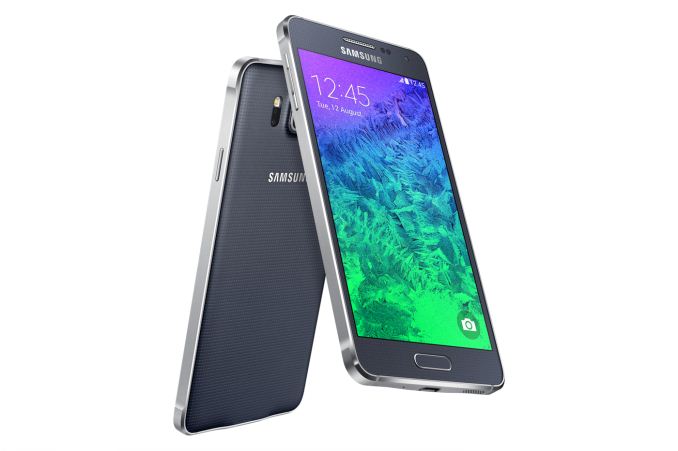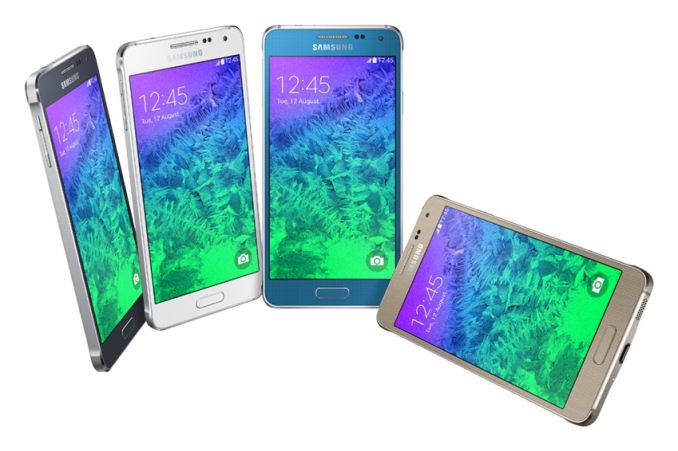Samsung launches the Galaxy Alpha
by Andrei Frumusanu on August 13, 2014 4:51 AM EST- Posted in
- Smartphones
- Samsung
- Mobile
- Galaxy Alpha

Samsung today announces the new Galaxy Alpha, a mid-range "premium" built device that creates a new range in Samsung's lineup. The Alpha totes a 4.7" 1280x720 AMOLED screen, coming with either a yet unnanounced Exynos 5430 SoC with 4 A15 cores running at 1.8GHz and 4 A7 cores running at 1.3GHz and a Mali T628MP6 GPU for the international market, or with a Snapdragon 801 SoC for select markets such as the US. Both versions come with 2GB of memory on board.
A new 12MP rear sensor and a 2.1MP front camera can be found.
The device comes in a new aluminium frame, marking this as a change in build material from Samsung's usual plastic. The phone is extremely thin at only 6.7mm and weighing a lightweight 115g. The footprint of 132.4 x 65.5mm matches the 4.7" screen format of the phone. The back cover is removable and sports a 1860mAh replaceable battery. Strangely, Samsung omitted a microSD card slot in this device which comes at a standard 32GB of internal storage space. We find the same fingerprint and heatbeat sensor as on the S5, however it lacks the waterproofing of the former. It's shipping with Android 4.4.4 KitKat version with the same TouchWiz iteration as the S5.
More interestingly the international version of the device should sport LTE-A category 6 with help of an Intel XMM7260 modem. This would be the first device announced with Intel's new LTE modem and mark a break from Qualcomm's dominance in the sector.
The Alpha is an intriguing device that apparently to wants to fill in a gap in Samsung's lineup which has seen device size go up with each iteration of the S-series. The 720p screen, its slimness and design seems to target directly the iPhone instead of other high-end Android handsets, pricing should also end up in the higher end.
Source: SamsungTomorrow











62 Comments
View All Comments
jjj - Wednesday, August 13, 2014 - link
The battery seems rather small and the price is likely to be ridiculous given the S5 Mini pricing.As for this
" Intel's new LTE modem and mark a break from Qualcomm's dominance in the sector."
Might be but it doesn't mean much. The real threat to Qualcomm is Mediatek starting to sell LTE and most Mediatek based phones end up with no price premium for LTE. So Qualcomm is likely to get some margins erosion and for Intel it will be hard to get wins when the 2 big names fight for share.
PS: since someone is bound to go crazy because i've called Mediatek a big name, they are likely to ship some 350 million smartphone SoCs this year, almost 30% of the market and they are about to reach 2 billions revenue per quarter so more than most semi companies. Next year if you exclude RAM and NAND makers (Samsung , Micron, Hynix ,Toshiba) they are likely to get into top 5 with just Intel, Qualcomm and TI ahead of them.
Andrei Frumusanu - Wednesday, August 13, 2014 - link
We have yet to see MediaTek have any big design wins with the big OEMs and have any real penetration in the western market, Intel is much better positioned at the moment to win market share from Qualcomm in that regard considering Samsung is their biggest costumer.jjj - Wednesday, August 13, 2014 - link
Have you seen who the big OEMs are? Most of the top 10 OEMs are China based now plus this is the time of the small and regional players. And how exactly is the western market what matters?The so called western market is not all that big. China is almost 40% of the smartphone market now, India will surpass the US in units in 2016 and has huge room to grow further. The US is maybe 12% of the market now and can only decrease, Western Europe is maybe 17% of the market now.
As for Intel and Samsung, not only Samsung will never work with a single partner,they also have their own baseband and will keep working on it because they need it.Samsung is also bleeding share and will need huge price cuts in the next years to keep share, if they don't their share will crumble.
Intel needs to integrate and get some wins but they are not at all in a favorable position since both Qualcomm and Mediatek will be pushing hard.
GKR - Friday, August 15, 2014 - link
Surprisingly, MediaTek did not win also in the first round of CMCC selection for the TDD LTE devices. It was Marvell that made it to the list of approved SOC's for the TDD-LTE network. MediaTek is yet to show any win in China for LTE. Having missed the next Samsung device, it would be interesting to see how this is going to affect MediaTek's revenue.bigstrudel - Sunday, August 17, 2014 - link
The western market means less every year. That's why Qualcomm is switching to Stock ARM cores on the 810: To compete with discount SoC makers from China and elsewhere. Cheap parts will rule the market in the coming years.99% of people don't care about speed. They care about fluidity and low price. Even MediaTek A7 designs run Android fluidly now.
lilmoe - Wednesday, August 13, 2014 - link
Am I the only one that thinks this isn't a mid-range phone at all? Am I also the only one who thinks 720p on a 4.7" is perfectly fine? The lower resolution is actually even better since we'll be getting more performance and battery life (relatively). Anyway, this SoC (Exynos 5430) should be a bit faster than the Note 3's, so things should be more zippy at that resolution and all games will most definitely play at 60fps.The only two downsides of the phone, I believe, are the exclusion of the usual SD card slot and the relatively smaller battery. The battery thing "should?" be understandable given the size and slimness of the device, and the processor should be more efficient since it doesn't need to ramp up its speed for trivial tasks (as it would on a 1080p+ resolution)... But hey, it comes with 32GB standard storage, which is obviously a good thing. Everything spec about this phone is at least better/much better than the iPhone 5S, so why would anyone call it mid-range?
These are all speculations, we'll have to see real world numbers. And Samsung AMOLED screens are getting better and better with each iteration.
Gich - Wednesday, August 13, 2014 - link
Mid-range doesn't mean is shit, just that are higher spec available...lilmoe - Wednesday, August 13, 2014 - link
Well yea, there's always "better specs" available. What matters is the "right specs" on a specific device IMHO. The only thing you're probably referring to is the screen, which on the contrary, I believe is a good thing (I seriously hope the GS6 doesn't go over 1080p for its display). Like I said, the only downside is the size of the battery (not the battery life per say, since we don't have the numbers yet), and the omission of the SD card slot... A slightly thicker device with a 2000-2200 mah battery would have been a better deal, but would have probably made it look a bit bulky looking with that metal trim.robertkoa - Tuesday, August 19, 2014 - link
The HTC One M8 is 40% thicker Device and most love how it looks.Having a super thin Device is very over rated IMO- especially when it limits battery size, removes SD Card.
AND the Camera protrudes UP above backplate anyway....
9 or 10 mm thick and limitations go away.
Next Big Thing - pixel density controlled at Menu, Ultra High Density for Media, High Density for Battery Life, Business etc.
hlovatt - Wednesday, August 13, 2014 - link
How do you get every spec is better than 5S, according to AnandTech review, obviously the best, the 801 processor is no match for the 5S. Also the screen is unlikely to be as bright, the battery life is likely to be shorter, the 5S comes with bigger storage if you want, it lacks sensors and a low power data logger, and the finger print reader is poor. Therefore if it sells at the same price it is no where near as good value.